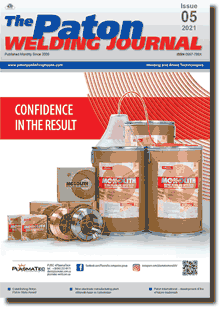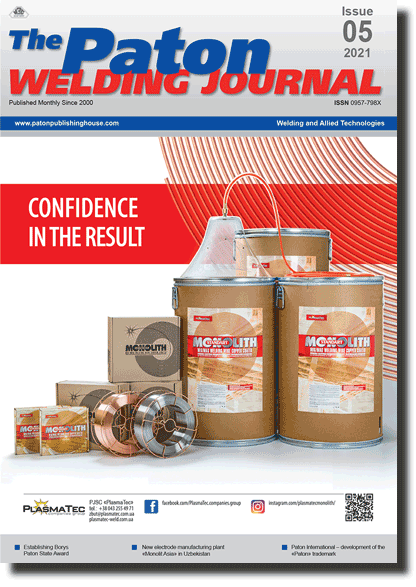Access for download PDF files for subscribers and for reviewers of scientometric bases.
Organization: Elsevier for content access(PDF files of journals released before 2024 are available for download from the website's archives))
Organization: Elsevier for content access(PDF files of journals released before 2024 are available for download from the website's archives))
| 2021 №05 (10) |
DOI of Article 10.37434/tpwj2021.05.11 |
2021 №05 (01) |

The Paton Welding Journal, 2021, #5, 65-68 pages
Application of fractal and metallographic analyses for evaluation of quality of weld metal
O.O. Shtofel2, V.V. Holovko1 and T.G. Chyzhska2
1E.O. Paton Electric Welding Institute of the NASU. 11 Kazymyr Malevych Str., 03150, Kyiv, Ukraine. E-mail: office@paton.kiev.ua
2National Technical University of Ukraine «Igor Sikorsky Kyiv Polytechnic Institute» 37 Peremohy Prosp., 03056, Kyiv, Ukraine
Abstract
When analyzing the factors that determine the mechanical properties of welds, it is necessary to take into account both the size of individual components of the structure and their morphology. It is shown that the use of the method of fractal analysis makes it possible to numerically determine such parameters of weld metal microstructure, as the size of nonmetallic inclusions, and branching of grain boundaries, which was impossible at analysis of metallographic images. The results are obtained, which indicate the need to include in the multifractal analysis the characteristics that describe the morphological features of microstructural components, the distribution of nonmetallic inclusions by size, and the level of alloying of the solid solution. Research directions for the development of multifractal analysis of welded joints have been identified. 10 Ref., 2 Tables, 6 Figures.
Keywords: metal of welded joints, fractal and metallographic analyses, structural parameters, mechanical characteristics
Received 30.03.2021
References
1. Shtofel, O., Golovko, V., Chyzhska, T. (2021) Fractal and metallographic analyses as an innovation in ensuring the quality of metal products. Innovative «Approaches to Ensuring the Quality of Education, Scientific Research and Technological Processes». Wydawnictwo Wyższej Szkoły Technicznej w Katowicach, 1013-1018. (ISBN 978-83-957298-6-7).2. Kirichenko, L.O., Radivilova, T.A. (2019) Fractal analysis of self-similar and multifractal hour series. Kharkiv, Kh-NURE [in Ukrainian].
3. Haken, G. (1980) Synergetics. Moscow, Mir [in Russian]. https://doi.org/10.1007/BF01073611
4. Nikolis, G., Prigozhin, I. (1979) Self-organization in nonequilibrium systems. From dissipative structures to order through fluctuation. Moscow, Mir [in Russian].
5. Mandelbrot, B. (2009) Fractals and chaos. Mandelbrot set and other wonders. Benoit Mandelbrot. Izhevsk, RDC Regular and chaotic dynamics [in Russian].
6. Shtofel, O.O. (2019) Application of fractal analysis method to study the metal structure. Metalozn. Obrobka Met., 91(3), 40-46 [in Ukrainian]. https://doi.org/10.15407/mom2019.03.040
7. Shtofel, O.O., Chizhskaya, T.G, Kulieznova, S.S. (2020) Metallographic studies of vessel steel samples: DS, 35G/40G and steel 20 by fractal analysis. J. of Multidisciplinary Engineering Sci. Studies (JMESS), 6, 2. ISSN: 2458-925X
8. Shtofel, O.O., Rabkina, L.M. (2019) Application of fractal analysis method to study the change of metal properties. Visnyk KPI, Seriya Pryladobuduvanniya, 58(2) [in Ukrainian]. ISSN (Online) 2663-3450, ISSN (Print) 0321-2211 https://doi.org/10.20535/1970.58(2).2019.189335
9. Holovko, V.V.,Kuznetsov, V.D., Fomichov, S.K., Loboda, P.I. (2016) Nanotechnologies in welding of low-alloy highstrength steels. Kyiv, Politekhnika [in Ukrainian].
10. Poyarkova, E.V. (2019) Fractal analysis in diagnostics of the structures of materials: Procedural recommendations. Orenburg, Orenb. State University [in Russian].
Suggested Citation
O.O. Shtofel, V.V. Holovko and T.G. Chyzhska (2021) Application of fractal and metallographic analyses for evaluation of quality of weld metal. The Paton Welding J., 05, 65-68.The cost of subscription/purchase order journals or individual articles
| Journal/Currency | Annual Set | 1 issue printed |
1 issue |
one article |
| TPWJ/USD | 384 $ | 32 $ | 26 $ | 13 $ |
| TPWJ/EUR | 348 € | 29 € | 24 € | 12 € |
| TPWJ/UAH | 7200 UAH | 600 UAH | 600 UAH | 280 UAH |
| AS/UAH | 1800 UAH | 300 UAH | 300 UAH | 150 UAH |
| AS/USD | 192 $ | 32 $ | 26 $ | 13 $ |
| AS/EUR | 180 € | 30 € | 25 € | 12 € |
| SEM/UAH | 1200 UAH | 300 UAH | 300 UAH | 150 UAH |
| SEM/USD | 128 $ | 32 $ | 26 $ | 13 $ |
| SEM/EUR | 120 € | 30 € | 25 € | 12 € |
| TDNK/UAH | 1200 UAH | 300 UAH | 300 UAH | 150 UAH |
| TDNK/USD | 128 $ | 32 $ | 26 $ | 13 $ |
| TDNK/EUR | 120 € | 30 € | 25 € | 15 € |
AS = «Automatic Welding» - 6 issues per year;
TPWJ = «PATON WELDING JOURNAL» - 12 issues per year;
SEM = «Electrometallurgy Today» - 4 issues per year;
TDNK = «Technical Diagnostics and Non-Destructive Testing» - 4 issues per year.


